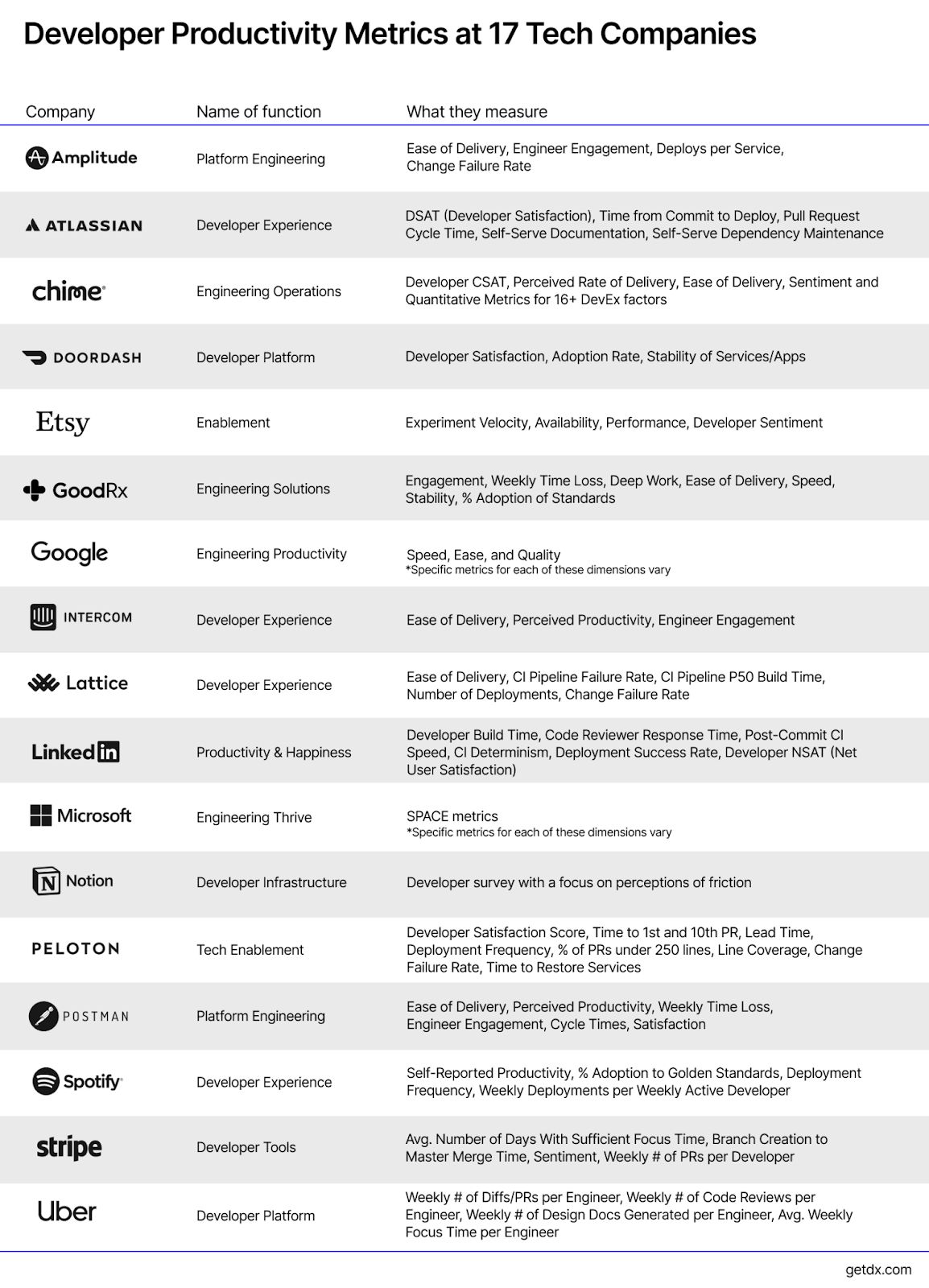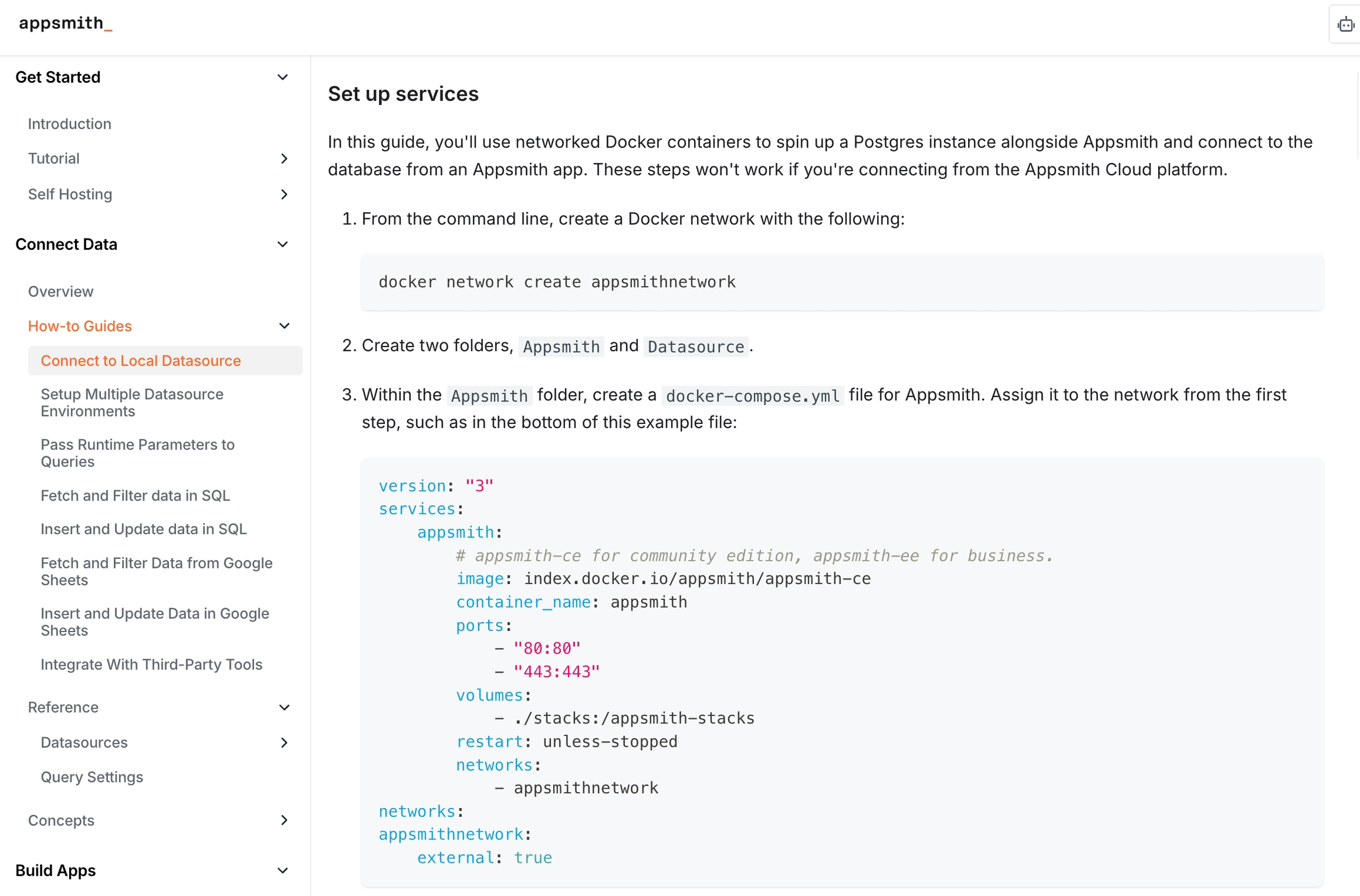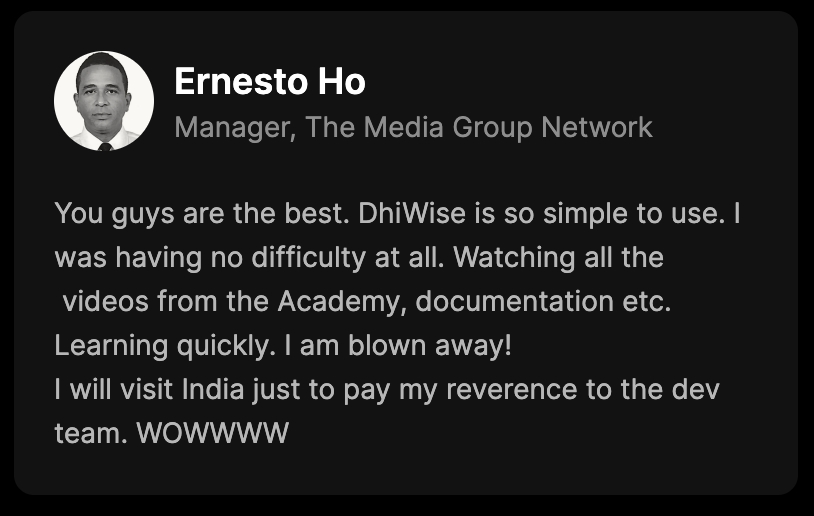📄Developer Experience
Do you have any questions, need personalized guidance, or want to share your journey in this playbook? We'd love to talk to you. Reach out to us.
Developer Experience (DX) is the experience developers have when they interact with your product and documentation. It usually comes after the discovery phase and is really important for converting them into product users. Before getting started, it's crucial to understand how developer productivity is measured. DevProd and DevEx teams, dedicated to enhancing developer efficiency, rely on various metrics to pinpoint issues, prioritize tasks, and gauge the impact of their efforts. Here's a snapshot of the key productivity metrics shared by these teams across different companies at the time of publication. As a devtool founder, you should aim to help engineering team do better with these metrics.

Now, let's start with Documentation. Documentation plays a crucial role in Developer Experience for several reasons:
Understanding: Good documentation provides clear and concise explanations of how to use a technology or API, helping developers understand its capabilities, features, and limitations.
Onboarding: Documentation serves as a guide for developers who are new to a technology, helping them get started quickly and efficiently. Well-structured documentation with tutorials and examples can significantly reduce the learning curve.
Troubleshooting: When developers encounter issues or errors, documentation can be a valuable resource for troubleshooting. It should include troubleshooting guides, FAQs, and known issues to help developers resolve problems independently.
Reference: Documentation serves as a reference guide for developers as they work with a technology over time. It should provide comprehensive information about all aspects of the technology, including configuration options, API endpoints, parameters, and return values.
Consistency: Good documentation promotes consistency in how developers use a technology across different projects and teams. It establishes best practices, conventions, and guidelines that help maintain code quality and reduce errors.
Documentation: it's part of your product
Do you know what the first things devs will look into when you get them interested? Docs and examples.
Devs want to answer questions:
how this works?
can I implement it in my workflow?
how much work will it be?
how does it solve X?
So good docs can make or break your conversion.
Crafting helpful documentation involves attention to detail and understanding the needs of developers at different stages. Good docs should cater to all kinds of developers, from beginners to experts.
One big step to having awesome docs is making them easy to access. If developers have to jump through hoops like signing up or paying, they're likely to give up. Keep things simple.
Choose a format that's easy to read, like using tools such as Readme.io or GitBook. These platforms allow collaboration and create web-based docs that are searchable and organized in a way that developers find familiar.
Avoid using PDFs for docs because they're clunky and hard to search.
When it comes to who creates the docs, involving the product team is common, but they might miss some important details since they're so close to the product. Having dedicated technical writers can help ensure the docs are clear and useful.
Remember, developers see documentation as part of the product experience, so keep it focused on providing useful information rather than adding unnecessary fluff. Give plenty of code examples and technical details to make things easier for developers.
Example: Code snippets in Appsmith Docs

Documentation as a SEO channel:
Your docs can be an amazing channel.
For example, Stripe managed to rank #1 on Google for the keyword "3d secure" with the docs page https://stripe.com/docs/payments/3d-secure

Who should write it
In the early stages of a startup, documentation often takes a back seat to other aspects of product development. However, it's just as crucial as the product itself. That's why we recommend founders or founding engineers take the lead on documentation for several key reasons:
Vision Alignment: Founders have a clear vision of the product and its goals. By spearheading documentation efforts, they ensure that the documentation accurately reflects this vision, keeping the team aligned and preventing divergence from the original goals.
Technical Expertise: Founders and founding engineers typically possess a deep understanding of the technology stack and product architecture. They're best suited to create comprehensive technical documentation that covers all aspects of the system accurately.
Setting Standards: Documentation crafted by founders establishes standards and best practices for the team. It defines conventions, coding guidelines, and architectural principles that ensure consistency and maintainability as the product evolves.
Rapid Iteration: Startups iterate quickly in the early stages, making frequent changes to the product. Founders can update documentation in real-time to reflect these changes, ensuring the team always has access to the latest information.
Knowledge Transfer: Founders play a crucial role in transferring their knowledge and expertise to new hires and team members. By documenting design decisions, implementation details, and lessons learned, they streamline the onboarding process and shorten the ramp-up time for new team members.
Building Culture: Taking ownership of documentation underscores the importance of communication, transparency, and accountability within the team. It cultivates a culture where documenting decisions and sharing knowledge is ingrained, fostering a collaborative and efficient work environment.
Example: Dhiwise
Dhiwise understands the importance of empowering users through comprehensive documentation. Vishal (Founder) explains,
"We strive to provide our users with all the resources they need to succeed." From detailed guides to API documentation, Dhiwise ensures that users have access to the information they need to make the most of their product.

Vishal emphasizes, "Clear and comprehensive documentation is like a roadmap for our users. It helps them navigate through the features and functionalities of our product with ease."
"We've seen a significant reduction in support tickets and inquiries since we ramped up our documentation efforts. Our user satisfaction scores have also improved, indicating that our users are finding value in the resources we provide."
Additionally, Dhiwise tracks metrics such as documentation page views, time spent on documentation pages, and feedback from users to continuously refine and enhance their documentation strategy.
They even created their own universtiy and crash course. check it out below:
Example: ToolJet
One of the first steps Navaneeth (Founder, ToolJet) took was to ensure that ToolJet's documentation was thorough, clear, and accessible. Detailed documentation helps users understand the full capabilities of ToolJet and serves as a valuable resource for troubleshooting and learning.
"We focused on creating detailed and clear documentation. It’s essential for users to have a go-to resource that answers their questions and helps them navigate the tool effectively."
Last updated
Was this helpful?